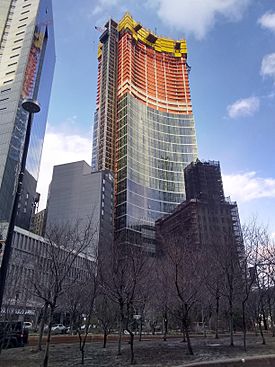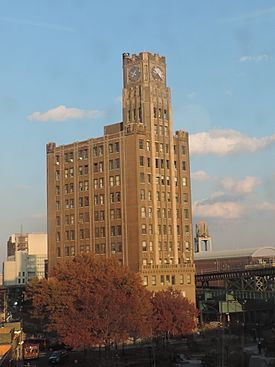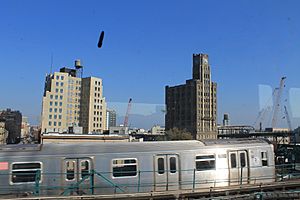Queens Plaza Park facts for kids
Quick facts for kids Queens Plaza Park |
|
|---|---|

Seen in February 2020
|
|
| General information | |
| Status | Topped-out |
| Type | Residential |
| Location | 29-37 41st Avenue Long Island City, NY 11101 |
| Coordinates | 40°45′01″N 73°56′11″W / 40.75028°N 73.93639°W |
| Construction started | 2018 |
| Estimated completion | 2021 |
| Opening | 2021 |
| Height | |
| Roof | 755 ft (230 m) |
| Technical details | |
| Floor count | 67 |
| Floor area | 978,000 square feet (90,900 m2) |
| Design and construction | |
| Architect | Handel Architects |
| Developer | Durst Organization |
Queens Plaza Park, also known as Sven, is a very tall residential building in Long Island City, Queens, New York. It stands at 29-27 Queens Plaza North. At 755 feet (230 m) tall, it is the second-tallest building in Queens. Only Skyline Tower is taller. It is also one of the tallest buildings in New York City outside of Manhattan.
This building was one of many planned for Queens Plaza. This happened after a new building plan was approved in 2001. Queens Plaza Park was first planned as a hotel. Then it was going to be apartments for sale. Finally, it was planned as a 930-foot (280 m) super-tall skyscraper. The final plans were set in 2016. The building reached its full height in June 2020.
The project includes the old Chase Manhattan Bank Building. This is a 14-story clock tower and office building. It was built in 1927. It was the first skyscraper in Queens. Morrell Smith designed it for the Manhattan Company (now Chase Bank). It was the tallest office building in Queens until 1990. In 2015, the Chase Manhattan Bank Building became an official city landmark. It was then included in the design for Queens Plaza Park. It will now be the main shopping area for the new building.
Contents
What is Queens Plaza Park?
Queens Plaza Park is located at 29-27 Queens Plaza North. It sits on a unique piece of land. This land is shaped like a trapezoid. It is bordered by 41st Avenue, Queens Plaza North, Northern Boulevard, and 40th Drive. The main part of the building, where people live, is 710 feet (220 m) tall. When it is finished in 2021, it will be the second tallest building in Queens.
At the bottom of Queens Plaza Park, there will be shops. These shops will be inside the old Chase Manhattan Bank Building. This building is a 14-story office building with a clock tower. It was known as "the first skyscraper in Queens." The new residential part of Queens Plaza Park was first planned to be the tallest in Queens. However, Skyline Tower ended up being taller. The project is also officially called Sven. This name has been used since late 2019.
Living in the Skyscraper
The new building will have 958 apartments for rent. About 300 of these apartments will be affordable. This means they will cost less for people to rent. The building will have many cool features for residents. These include an outdoor swimming pool and a large gym. There will also be a private library and a co-working space. Kids will have their own playroom. There will even be a kitchen for cooking demonstrations.
Next to the tower, there will be a public park. This park will be about 0.5-acre (2,000 m2) in size. The outside of the entire building is made of glass. The side facing Queens Plaza curves inward. This gives it a unique look. The inside of the apartments will be designed by Selldorf Architects. The curved design of the building by Handel Architects has been compared to a building in London called 20 Fenchurch Street.
The Historic Chase Manhattan Bank Building
| Chase Manhattan Bank Building | |
|---|---|

Prior to addition of residential towers
|
|
| Alternative names | Bank of the Manhattan Company Building, Queens Clock Tower Building |
| General information | |
| Status | Complete |
| Architectural style | Neo-Gothic |
| Address | 29-27 41st Avenue |
| Town or city | Long Island City, Queens, New York City |
| Coordinates | 40°45′00″N 73°56′11″W / 40.75000°N 73.93639°W |
| Completed | 1927 |
| Cost | $1,000,000 |
| Height | |
| Architectural | 207 ft (63 m) |
The Chase Manhattan Bank Building is also called the Queens Clock Tower. It is located at the southern end of the Queens Plaza Park property. It has 11 floors of offices and a 3-story clock tower on top. Morrell Smith designed the building. He also designed other branches for the Manhattan Company. Until 1990, it was the tallest business building in Queens. In 2015, it was named an official city landmark.
As part of the Queens Plaza Park project, the old Chase Manhattan Bank Building will change. It will become the shopping area for the new residential building. It will have over 50,000 square feet (4,600 m2) of space for stores. The building is made of light brown brick and Indiana Limestone. It looks like a column with a base, a middle part, and a top. The base is made of limestone. It used to have a large banking hall. The side facing Queens Plaza had three sections with windows. The main entrance was made of stone. It had a Gothic Revival design above it. This design showed Oceanus, a Greek god. He was also the symbol for the Manhattan Company.
Later, a modern glass wall replaced the old entrance. Inside, there was a lobby with elevators to the upper floors. There was also a bank vault in the basement. On the upper floors, the south side of the building has three vertical sections. The light brown brick stands out against the darker brick. This side has a pattern of 2-3-2 windows. The clock tower is above the middle section. It has clocks on all four sides with Roman numerals. This made it the second building on Queens Plaza with a clock tower. The Brewster Building was the first. The clocks are special non-winding clocks. Above the "XII" mark on each clock face are stone carvings in a Gothic style. The tower also has carvings of gargoyles. It has a castle-like top, copper windows, and granite shields. There used to be a sign on the roof next to the tower. It faced east and advertised the Manhattan Company.
History of the Buildings
The Old Bank Building
Queens Plaza was built because the Queensboro Bridge connected to Queens Boulevard in 1909. After this, many new buildings were built in the area. The Queensboro Plaza station, a large subway station, opened in 1916–1917. This brought even more development. Queens Plaza became like a "new downtown" for the area. From the 1920s through World War II, Queens Plaza had many factories and warehouses. Some of these later became office buildings. It also became a financial center with several banks.
The Manhattan Company was one of the banks that moved to Queens Plaza. It started in 1799 in Manhattan. The Manhattan Company began expanding into Queens in 1910. They bought part of the Bank of Long Island. Ten years later, the two companies merged. At that time, the Manhattan Company had 13 locations in Queens. One of these was at 5 Skillman Place. This later became the site of the Bank of the Manhattan Company Building.
The company made plans for a new office and bank building. They submitted these plans in 1924. The plans, announced in October 1925, were for a 14-story building. It would have 11 floors of offices and a 3-story clock tower. The building was built by Charles T. Wills, Inc. It cost $1 million to finish.
When it was completed in May 1927, the Manhattan Company's building was called "the first skyscraper in Queens." It was the tallest commercial building in Queens until One Court Square was finished in 1990. The Manhattan Company had bank vaults in the basement. They also used the ground and mezzanine floors for their bank. When it was finished, the building had the most office space in Queens. Many of the businesses renting space were new to Queens. In 1928, the Queensboro Chamber of Commerce named it the best building in Queens.
A small addition was built at the back of the building. It was built in two parts between 1928 and 1933. After the Manhattan Company became Chase Manhattan, the original decorations were removed from the base. A glass front was added around the mid-1960s. The bank branch closed in 1984 and was sold four years later. The sign on the roof was taken down by 2004. The building was empty from 1984 until 2012. For a short time, the vaults and clock tower were used for art displays. From 2013 to 2014, a holographic arts center used the building.
Building Queens Plaza Park
Early Ideas for the Site

In 2001, new rules allowed tall residential buildings in Long Island City. The land where the Chase Manhattan Bank Building stood was first planned for a 16-story hotel. But money problems caused the developers to go bankrupt. Steve Cheung then bought the land for $8.3 million. He planned to build a 30-story apartment tower. This new building was going to be the first super-tall skyscraper in New York City outside Manhattan. It would have apartments for rent and for sale. It would be 900,000 square feet (84,000 m2) big and have 800 apartments.
People who wanted to save old buildings tried to make the Bank of the Manhattan Company building a landmark. In 2014, two companies, Property Markets Group (PMG) and Hakim Organization, bought the clock tower building from Cheung for $30 million. They also bought the land around it for $46.3 million. This made people worried that the old building might be torn down.
In March 2015, PMG and Hakim planned a 930-foot (280 m), 77-story tower. This tower would be built on the block around the bank building. This height was possible because they could use "air rights." These are rights to build higher that were not used by the Metropolitan Transportation Authority (MTA). The MTA's East Side Access tunnel runs right under the planned building. The MTA sold the land above the tunnel to PMG and Hakim in March 2015. They also used air rights from the Chase Manhattan Bank Building. Without these extra rights, the new building could only be 38 stories tall. This is because the planned size was much larger than what was allowed. In May 2015, the New York City Landmarks Preservation Commission voted to make the old 11-story bank building and clock tower city landmarks.
New Plans and Building Work
In 2016, the Durst Organization bought the land for $175 million from PMG. They planned to build a residential tower. The previous developers said they didn't have enough "power" (money and resources) to finish the project. Durst kept the name Queens Plaza Park. A smaller design was announced in April 2018. It called for a 710-foot-tall tower with 63 stories. The new residential tower would curve around the old bank building at its base.
The building's foundations were finished in December 2018. Building the foundations was hard. They had to work carefully around the Chase Manhattan Bank Building. Later that month, the project got a $360 million loan from M&T Bank to help with construction. Work on the curved glass outside of the building started in October 2019. Two months later, the project was more than halfway done. The developers also planned to fix the four clocks on the Chase Manhattan Bank Building. This was expected to be finished in late 2020. The residential tower reached its full height in June 2020.
See also
 In Spanish: Queens Plaza Park para niños
In Spanish: Queens Plaza Park para niños

